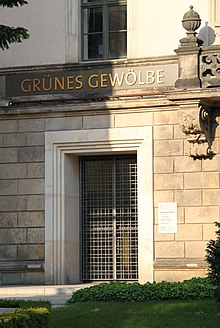This article has multiple issues. Please help improve it or discuss these issues on the talk page. (Learn how and when to remove these messages)
|
| Weight | 62 carats (12.4 g) |
|---|---|
| Color | D |
| Type | IIa |
| Cut | Cushion |
| Country of origin | |
| Discovered | 17th –18th century |
The Dresden White Diamond (also known as Dresden White or the Saxon White) is a 62-carat (12.4 g) cushion-cut diamond that probably originated from the Golconda mines in Southern India.
The Dresden White's name is derived from Dresden, the capital city of Saxony, Germany, and from the gem's white color.
History
When the diamond was first shown to Frederick Augustus I, the King of Saxony, he was so captivated by the cut, clarity, and color of the gem that he chose to acquire it at any cost. He supposedly paid somewhere between $750,000 and $1,000,000 for the diamond.

In order to house his enormous collection of treasures, he set up the Green Vault in Dresden Castle.
In 1746, goldsmith Jean Jacques Pallard designed the elaborate Golden Fleece ornament for Frederick Augustus and the Dresden White was placed at the top of the design. However, after the end of the Seven Years' War the Golden Fleece was broken up. The Dresden White was then incorporated into a shoulder knot ornament designed around 19 large diamonds and 216 small stones.
After World War I, the items in the Green Vault were put on public display. They remained there until the beginning of World War II, when they were placed back under lock and key. At the height of the war in 1942, the items were transferred to the Königstein Fortress.
In 1945, the Soviet Trophies Commission took the Green Vault contents to Moscow, but safely returned them in 1958. The contents were then placed on display in Dresden's Albertinium, which was built on the same site as the original Dresden museum.
On November 25, 2019, a group of thieves stole much of the jewelry in the Green Vault during the 2019 Dresden heist, including the White Diamond.
On November 17, 2020, three people were arrested in Berlin in connection with the theft. The police operation of 1,638 officers focused their search mainly in Neukölln, southern Berlin.
See also
References
- ^ "Dresden White Diamond". InternetStones.com. Archived from the original on 2008-07-05. Retrieved 2019-11-30.
- Balfour, Ian (1987). Famous Diamonds. Collins. p. 76. ISBN 9780004122465.
- Givetash, Linda and Carlo Angerer (2019-11-28). "62-carat diamond among nearly 20 jewels stolen in German museum heist". NBC News. Retrieved 2019-11-30.
- "Police offer €500,000 reward over Dresden diamond heist". The Guardian. Agence France-Presse. 2019-11-28. ISSN 0261-3077. Retrieved 2019-12-01.
- "Three arrested over spectacular Dresden museum jewellery heist". Al Jazeera. Al Jazeera Media Network. 17 November 2020. Retrieved 22 February 2022.